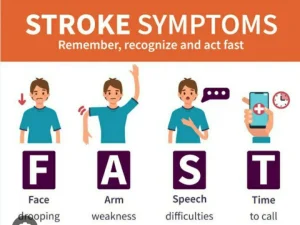IN A NUTSHELL Editor's noteStroke risk awareness should increase in Africa where this disease is the third leading cause of death, accounting for about 9% of all deaths on the continent, due to factors including high blood pressure, diabetes, obesity, smoking, and lack of access to healthcare services

By Kirubel Workiye Gebretsadik
Medical Doctor, Ras Desta Damtew Memorial Hospital
Addis Ababa, Ethiopia
Stroke Awareness and Africa
Stroke is a medical condition that affects millions of people around the world, including the African population. It is a serious and potentially life-threatening condition that occurs when the blood supply to the brain is disrupted(1).
May is Stroke Awareness Month, a time dedicated to increasing awareness about stroke, its causes, and its impact on individuals and families(2).
African countries are facing a growing burden of stroke cases. According to the World Health Organization (WHO), stroke is the third leading cause of death in Africa, accounting for about 9% of all deaths on the continent. The prevalence of stroke in Africa is higher compared to other regions, and it affects individuals at a younger age. This can be attributed to various factors such as high blood pressure, diabetes, obesity, smoking, and lack of access to healthcare services(3).
One of the major challenges in addressing stroke in Africa is the lack of awareness and knowledge about the condition. Many people are unaware of the risk factors and warning signs of stroke, which delays the timely recognition and treatment of the condition. It is crucial to educate the population about stroke, its symptoms, and the importance of seeking immediate medical attention.
Many individuals may not recognize the symptoms of a stroke or may delay seeking medical help, resulting in delayed treatment and poorer outcomes. Therefore, it is crucial to educate the public about the signs and symptoms of a stroke and emphasize the importance of seeking immediate medical attention.
Recognizing the warning signs of stroke is crucial for getting prompt medical attention and preventing long-term damage.
The acronym “BE FAST” is an easy way to remember the signs of stroke:
- Balance: sudden loss of balance or headache
- Eyes: Is vision blurry
- Face drooping: Does one side of the face droop or feel numb?
- Arm weakness: Is one arm weak or numb? Ask the person to raise both arms. Does one arm drift downward?
- Speech difficulty: Is speech slurred or hard to understand? Ask the person to repeat a simple sentence, like “The sky is blue.”
- Time to call: If someone shows any of these symptoms, call to hospital immediately.
Prevention plays a vital role in reducing the burden of stroke in the population. Adopting a healthy lifestyle can significantly lower the risk of stroke. This includes maintaining a balanced diet, engaging in regular physical activity, avoiding tobacco and excessive alcohol consumption, and managing underlying conditions such as high blood pressure and diabetes(4). Access to quality healthcare services and medications for risk factor control is also crucial in preventing strokes. In conclusion, stroke has a significant impact on the African population, with higher prevalence and younger age of onset compared to other regions. Raising awareness about stroke, recognizing its symptoms, and promoting preventive measures are essential to reduce the burden of stroke in Africa. By working together to educate communities and improve access to healthcare services, we can make a difference in the lives of millions affected by stroke in Africa. Remember, timely action can save lives. Stay informed, stay healthy(5).
Stroke Awareness Month is an opportunity to spread the word about stroke prevention, recognition, and treatment. By raising awareness, we can help more people understand the risk factors, warning signs, and actions to take in the event of a stroke(6).
References
- World Stroke Day | American Stroke Association [Internet]. [cited 2024 May 11]. Available from: https://www.stroke.org/en/about-the-american-stroke-association/world-stroke-day
- Stroke – Society for Public Health Education – SOPHE [Internet]. [cited 2024 May 11]. Available from: https://www.sophe.org/focus-areas/chronic-conditions/may-national-stroke-awareness-month/
- World Stroke Day 2022 [Internet]. [cited 2024 May 11]. Available from: https://www.who.int/srilanka/news/detail/29-10-2022-world-stroke-day-2022
- strokeawareness [Internet]. [cited 2024 May 11]. Help Spread Stroke Awareness | Stroke Awareness. Available from: https://www.strokeawareness.com/patient/spread-the-word.html
- Elshebiny A, Almuhanna M, AlRamadan M, Aldawood M, Aljomeah Z. Awareness of Stroke Risk Factors, Warning Signs, and Preventive Behaviour Among Diabetic Patients in Al-Ahsa, Saudi Arabia. Cureus. 15(2):e35337.
- Stroke Awareness Foundation: Improving Stroke Outcomes [Internet]. [cited 2024 May 11]. Available from: https://www.strokeinfo.org/
—-
By the same Author on PEAH Neglected Tropical Diseases: Lessons for Future Pandemics and Global Health Preparedness Forgone Health Care Among Patients With Cardiovascular Disease UNMET HEALTHCARE Malaria Eradication and Prevention through Innovation ONE HEALTH ONE WORLD Social Innovation in Healthcare
